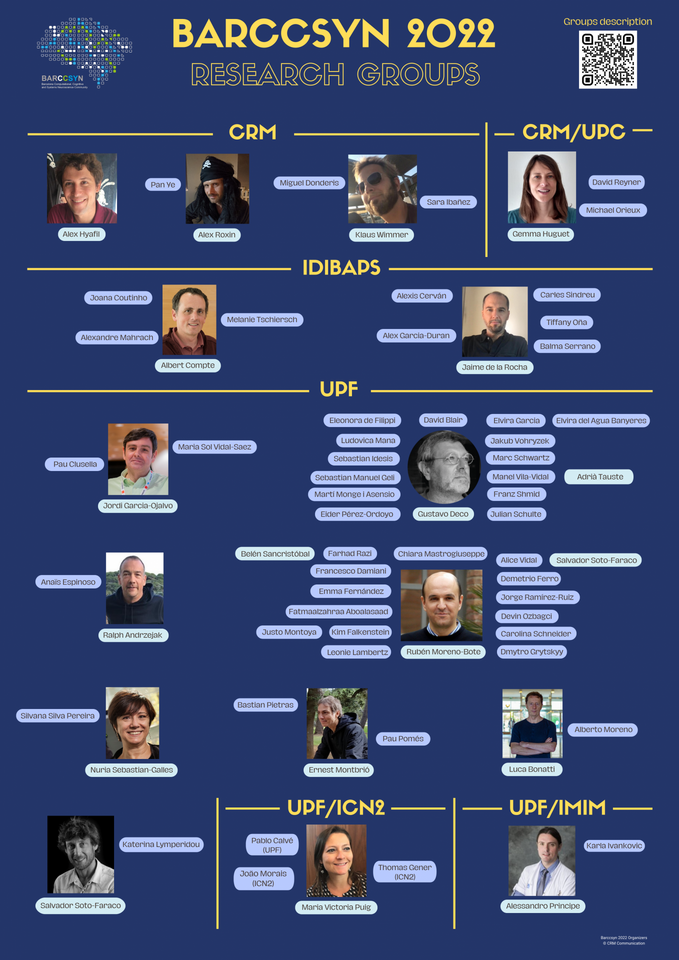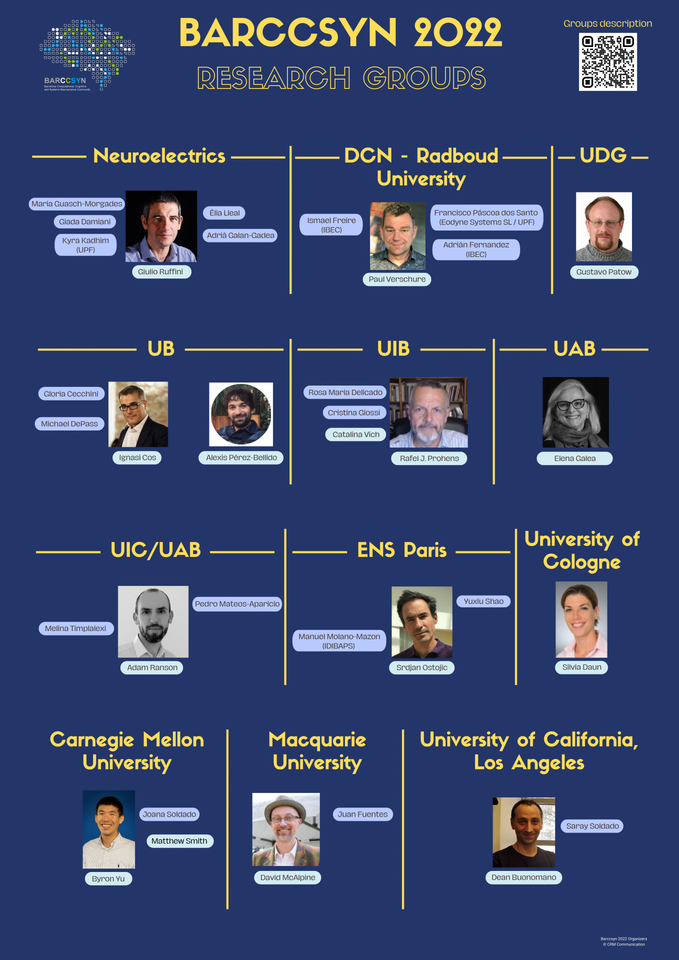BARCCSYN 2022: RESEARCH GROUPS


CRM
Alex Hyafil
Alex Hyafil’s group investigates the computational mechanisms that underlie perception and decision-making, through a mix of modelling, psychophysics and analysis of behavioral and neural data from collaborating experimental groups.
Alex Roxin
The research focus in the group of Alex Roxin is on dynamical and network mechanisms in systems neurosciene. We model cognitive processes such as long-term memory formation and decision making, but also study the dynamical repertoire of neuronal networks more generally.
Klaus Wimmer
We study neural circuit dynamics underlying cognitive function. In particular, we work on developing computational models of cortical circuits to shed light on the neural network dynamics underlying an animal’s behavior during elementary cognitive tasks such as working memory and perceptual decision making. Modelling efforts are complemented by analysis of typically high-dimensional neural data obtained by collaborators (e.g. simultaneous recordings from large populations of neurons or human neuroimaging data) involving state-of-the-art statistical and machine learning tools.
CRM/UPC
Gemma Huguet Casades
Dynamical Systems Group at UPC. We study mathematical aspects of computational neuroscience using tools from Dynamical systems. Current projects involve the development and analysis of mathematical models to elucidate the role of oscillations in cognitive tasks and inverse problems such as estimation of synaptic conductances.
IDIBAPS
Albert Compte – Jaime de la Rocha
Our goal is to understand the neuronal network mechanisms underlying the cognitive functions of perceptual decision making and working memory. We are also interested in characterizing the alterations of these mechanisms occurring in patients and animal models of different brain disorders (e.g. autoimmune synaptopathies).
UPF
Ralph Andrzejak
Our research is positioned at the interface between physics, applied mathematics, and neuroscience. One of our main targets is the development of innovative nonlinear time series analysis techniques. These techniques aim to characterize dynamical systems for which nonlinearities cause a complicated temporal evolution. A further main target of our work is the application of nonlinear time series techniques to electrophysiological recordings from the brain of epilepsy patients. We furthermore study coupled oscillator network models that show so-called chimera states.
Luca Bonatti
Gustavo Deco
Elucidate the computational principles underlying higher brain functions (that require the integration of specialized but widely distributed brain areas) and their breakdown in brain diseases. They integrate different levels of experimental investigation (e.g., neuroanatomy, neurophysiology, neuroimaging, neuropsychology) in cognitive neuroscience via a unifying theoretical framework that captures the neural dynamics inherent in the computation of cognitive processes.
Jordi Garcia-Ojalvo
The Dynamical Systems Biology lab at UPF is interested in the stochastic and nonlinear dynamics of living systems, from bacteria to the human brain. We use biochemical, electrophysiological and imaging data to guide mathematical models of living systems, and thereby unravel the mechanisms underlying physiological processes.
Ruben Moreno Bote
In our lab we combine computational and cognitive neuroscience to theorize above and study the neuronal mechanisms that underlie cognitive functions. Physics, machine learning, psychology and neuroscience are used to understand the computational principles of the brain.
Ernest Montbrió
Nuria Sebastian-Galles
How do infants growing up in bilingual homes learn words and how are these words represented in the infant bilingual mind? A critical property of adult bilingualism is that of non-selective access to the words in both languages. We propose to conduct a series of experimental studies to uncover the structure of the mental lexicon in bilingual infants, and to construct brain-inspired models to explore theoretical accounts of the structure of their lexicon(s).
Salvador Soto Faraco
The Mutisensory Research Group (MRG) is part of the Center for Brain and Cognition, Department of Information and Communication Technologies at the Universitat Pompeu Fabra. Our aim is to understand the neural and cognitive bases of human perception and attention in multisensory environments. That is, how our brain organizes, represents, and selects the information that arrives from the different sensory modalities (audition, somatosensation, vision, olfaction, etc). Our approach spans across a wide range of perceptual domains from speech perception to body representation, using psychophysics and behavioural responses together with neuroimaging (EEG, fMRI, TMS, EyeTracking).
UPF/IMIM
Alessandro Principe
The research of this group focuses primarily on cognitive aspects and their correlation with surgical and electrophysiological procedures, as well as the pharmacotherapy of epilepsy and genetic diagnosis. The Epilepsy Unit primarily focuses its research on specific aspects of diagnosing the location of epileptic focus, as well as the electrophysiological and cognitive correlates of cerebral records obtained using invasive electrophysiological techniques.
UPF/ICN2
Maria Victoria Puig
Study of the neural substrates underlying serotonergic and dopaminergic modulation of neural network activity and inter-area communication and its impact on executive function. Deepen our understanding on the effects of typical (1st generation) and atypical (2nd generation) antipsychotic drugs on executive function and elucidate the cellular mechanisms involved. Study of the neural substrates underlying deficits in executive function of murine models of intellectual disability. We are currently evaluating a mouse model of Down syndrome (Ts65Dn mice with partial trisomy equivalent to human chromosome 21). We also investigate potential beneficial actions on cognition of pharmacological treatments, natural compounds and environmental stimulation in this animal model.
Neuroelectrics
Giulio Ruffini
Our group’s interests revolve around developing improved brain stimulation solutions for patients. Our vision is that computational neuroscience is the key to further progress. We are working on several projects to create (computational) “neurotwins” (as we call them) of patients to optimize transcranial current stimulation (tES) protocols in a personalized way. Neurotwins are based on neural mass whole-brain models. A differentiating factor of our approach is multimodal data assimilation (EEG, fMRI, dMRI, MRI) and including realistic physics models that connect the computational representation of neural activity with physical measurements (EEG, SEEG, fMRI) and interventions (tES).
DCN – radboud university
Paul Verschure
SPECS-lab.com is directed by Prof. Dr. Paul Verschure and hosted at the Donders Centre of Neuroscience at Radboud University in The Netherlands. SPECS research spans Neuroscience, Cognitive Science, Robotics, and Artificial Intelligence with the aim to develop a system-level theory of mind and brain, and to apply this theory to interventions and technologies that support and advance the human condition.To achieve the latter SPECS is linked to a number of spin-off companies and foundations.
UAB
Elena Galea
I seek to unravel the mechanisms whereby a brain cell called ‘astrocyte’ contributes to higher-brain functions —cognition, memory, emotion— and to establish the pathological consequences of astrocyte dysfunction. Three core ideas guide my research. First, astrocytes not only carry out homeostatic functions in support of neurons, but they also compute, i.e., they process information intelligently, plausibly by way of calcium transients. Second, astrocytes are superior therapeutic targets: increasing their resilience or restoring their malfunction in acute or chronic neurological diseases will have a beneficial impact on multiple pathological processes at once. Three, mathematics and systems biology —which has lately included artificial intelligence— are indispensable tools to clarify astrocyte (dys)function, identify astrocyte-based molecular signatures in human fluids, and develop astrocyte-targeted therapies.
UB
Ignasi Cos
We aim to develop neural and behavioural data analyses, as well as computational models, with a focus on system-level and large ensemble neuronal dynamics. We combine multi-electrode and multi-area neurophysiological data analyses, with sophisticated computational modelling of brain function. Alternatively, we use computational approaches to study how biologically realistic large-scale and recurrent neural network models simulate behavioural-level phenomena.
Alexis Pérez-Bellido
How do we encode, retain and integrate information to make decisions? Specifically I look at how we integrate past memories (prior knowledge) with new sensory evidence during the perceptual decision process. In order to answer this question I combine psychophysics, electrophysiology (EEG, iEEG) and fMRI neuroimaging techniques.
UIB
Rafel J. Prohens
The main research of the UIB Dynamical Systems group in neuroscience is based on the modelling of single cells using ordinary differential equations and the qualitative study of these models. We also investigate new strategies to estimate the synaptic conductance that a particular neuron receives from other neurons, discerning between excitatory and inhibitory inputs. Part of our team focuses on circuit-level adaptive decision making mechanisms using a biologically realistic spiking network model of the cortico-basal ganglia-thalamic network with a spike-timing dependent plasticity rule to simulate reinforcement learning.Universitat de les Illes Balears.
Udg
Gustavo Patow
At the Universitat de Girona we are building a small team of researchers interested in Computational Neuroscience, who are just starting and learning the tools of the trade. At this point the team is studying two different problems: Modeling Alzheimer’s disease and the effects of the different neuroreceptors on whole-brain mechanics.
UIC/UAB
Adam Ranson
Our group is focused on understanding the function, development and biological/circuit basis of sensation in different brain states. In particular we are interested in how sensory cortex integrates sensory data with top-down signals encoding prior experience and expectations, and how such top-down circuits are recruited depending upon current behavioural demands.
ENS Paris
Srdjan Ostojic
The aim of the research in my team is to understand how thousands of neurons work together to perform computations that underlie behavior. The research in the team combines mathematical modeling of cortical networks with computational analyses of neural activity recorded in behaving animals.
University of Cologne
Silvia Daun
Prof. Dr. Silvia Daun uses mathematical models and numerical simulations to study how rhythmic motor activity in the nervous system is generated, and how this leads to locomotion and movement control. To this end, she has studied insect locomotion in order to extract general principles of motor control. Using a multi-level approach (including the modeling of signal processing of single cells or cellular networks, neuromuscular coupling, muscle dynamics and movement mechanics of the limb) she has been successful in establishing a novel view on intra- and inter-limb coordination during multi-legged locomotion. Only recently she has extended her research interests to high-level motor control, which is of primary importance for the generation of goal directed motor behavior.
Carnegie Mellon University
Byron Yu
Our group seeks to elucidate how large populations of neurons process information, from encoding sensory stimuli to guiding motor actions. Most neurophysiological studies to date involve studying one neuron at a time. Although one neuron can be informative about the sensory stimulus or motor action, it often doesn’t tell the full story. While this provides the motivation for looking across a neural population, the heterogeneity of the activity of different neurons can be baffling. We have two major aims: (1) To develop and apply novel signal processing and machine learning algorithms to explain the high-dimensional structure and timecourse of neural population activity. (2) To apply this knowledge to the design of next-generation biomedical devices that interface with large populations of neurons. The work is at the intersection of signal processing / machine learning, biomedical engineering, and basic neuroscience.
Macquarie University
David McAlpine
Using state-of-the-art machine-learning approaches, we will develop a diagnostic tool for distinguishing those who report a perception of tinnitus from those who do not, based on a widely available clinical measure of hearing function, the auditory brainstem response (ABR) to simple sounds (acoustic clicks).
University of California
Dean Buonomano
The ability to tell time is among the most important functions the brain performs. Tasks such as, understanding speech, performing the complex movements necessary to catch a prey, and predicting when external events will occur, all rely on the brain’s ability to tell time. We have hypothesized that timing and temporal processing is such an important computation, that most neural circuits are capable of telling time on the scale of milliseconds and seconds. Our research suggests that how the brain tells time has little to do with how man-made clocks tell time (by counting the ticks of an oscillator), our hypothesis is that the brain tells time through the intrinsic dynamics of neurons and neural circuits. Our research focuses on how neural circuits learn and perform complex computations–such as telling time and temporal processing. Towards this goal our lab uses electrophysiological, optogenetic, computational, and psychophysical techniques.
